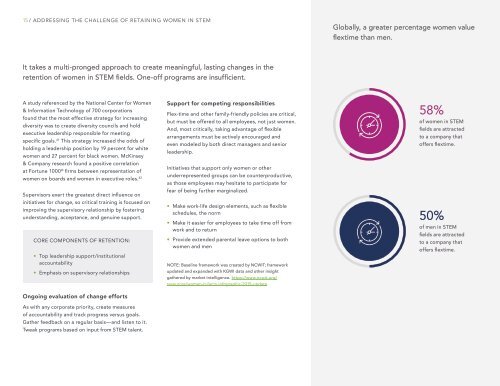WOMEN IN STEM
26AZ5bv
26AZ5bv
Create successful ePaper yourself
Turn your PDF publications into a flip-book with our unique Google optimized e-Paper software.
15 / ADDRESS<strong>IN</strong>G THE CHALLENGE OF RETA<strong>IN</strong><strong>IN</strong>G <strong>WOMEN</strong> <strong>IN</strong> <strong>STEM</strong><br />
Globally, a greater percentage women value<br />
flextime than men.<br />
It takes a multi-pronged approach to create meaningful, lasting changes in the<br />
retention of women in <strong>STEM</strong> fields. One-off programs are insufficient.<br />
A study referenced by the National Center for Women<br />
& Information Technology of 700 corporations<br />
found that the most effective strategy for increasing<br />
diversity was to create diversity councils and hold<br />
executive leadership responsible for meeting<br />
specific goals. 41 This strategy increased the odds of<br />
holding a leadership position by 19 percent for white<br />
women and 27 percent for black women. McKinsey<br />
& Company research found a positive correlation<br />
at Fortune 1000 ® firms between representation of<br />
women on boards and women in executive roles. 42<br />
Supervisors exert the greatest direct influence on<br />
initiatives for change, so critical training is focused on<br />
improving the supervisory relationship by fostering<br />
understanding, acceptance, and genuine support.<br />
CORE COMPONENTS OF RETENTION:<br />
• Top leadership support/institutional<br />
accountability<br />
• Emphasis on supervisory relationships<br />
Ongoing evaluation of change efforts<br />
As with any corporate priority, create measures<br />
of accountability and track progress versus goals.<br />
Gather feedback on a regular basis—and listen to it.<br />
Tweak programs based on input from <strong>STEM</strong> talent.<br />
Support for competing responsibilities<br />
Flex-time and other family-friendly policies are critical,<br />
but must be offered to all employees, not just women.<br />
And, most critically, taking advantage of flexible<br />
arrangements must be actively encouraged and<br />
even modeled by both direct managers and senior<br />
leadership.<br />
Initiatives that support only women or other<br />
underrepresented groups can be counterproductive,<br />
as those employees may hesitate to participate for<br />
fear of being further marginalized.<br />
• Make work-life design elements, such as flexible<br />
schedules, the norm<br />
• Make it easier for employees to take time off from<br />
work and to return<br />
• Provide extended parental leave options to both<br />
women and men<br />
NOTE: Baseline framework was created by NCWIT; framework<br />
updated and expanded with KGWI data and other insight<br />
gathered by market intelligence. https://www.ncwit.org/<br />
resources/women-it-facts-infographic-2015-update<br />
58%<br />
of women in <strong>STEM</strong><br />
fields are attracted<br />
to a company that<br />
offers flextime.<br />
50%<br />
of men in <strong>STEM</strong><br />
fields are attracted<br />
to a company that<br />
offers flextime.


